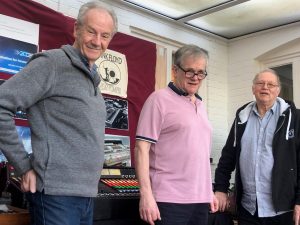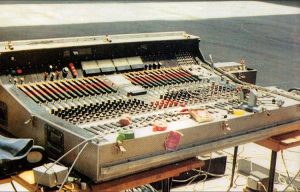CH Vintage Audio’s Chris Hewitt is noted for his collection of salvaged pieces from classic rock concerts of the 1960s and 1970s, which are curated and presented as exhibition curios. Last year’s PLASA Show drew the great and the good from that era to his stand like moths to a flame and the recent ISE Show even more so.
Having famously rebuilt (and displayed) Floyd’s Live at Pompeii WEM PA the missing piece was the original Allen & Heath 28/4 quadrophonic Allen & Heath mixer, built by Andy Bereza and Ivor Taylor, which was no longer in existence. This was used between 1971-74 (and mixed on by Alan Parsons and Chris Michie) before undertaking its final tour of duty on the Dark Side Of The Moon tour in 1974.

Andy Bereza, who had completed the build in 1971, and was only too happy to help with a redesign, when approached by Hewitt. Electronics wizard Geoff Goddard, duly entered the process, building the Veroboard channels based on Andy’s original circuits.
The desk’s history is worth recalling. Peter Watts, Floyd’s Chief Roadie had asked Andy Bereza to incorporate a large number of multi-coloured illuminated buttons (symbolic of the psychedelic era) and the original footprint was modified, including expansion of the chassis and adding the longer Penny and Giles faders. The square layout of the quad pan pots was also changed, adding extra meters in the middle of the desk.

Bereza remembered: “Peter Watts came to me with a huge A1 sheet of paper covered in fluorescent markers with different coloured knobs for every manageable area of the mixer.
“As far as I remember, each input could be assigned to stereo submixes and/or stereo main output busses; also to one or all of four quad buses (each with a quad panpot), and one or all of three FX busses (red assign buttons and green buttons respectively). I can’t remember how the FX (Binson echo unit) was returned to the desk.
“The metal bar at the right of the console tied the four tape input channels together (DSOTM had a prepared four-track tape which was cued and operated by Mick Klusczinski, but faded in and out by me.”
Recalling his own biggest challenges, Hewitt said this included, “finding items like 28-strip VU meters, one per input channel, and four large output meters, since these were no longer in production. Plus the 53-year-old circuit diagrams were found wanting. There were no output stage diagrams and no-one remembered how the output routing worked.”

But the efforts paid off, and when it was unveiled at this year’s ISE Show in Barcelona it evoked an emotional response. “People were hugging our team to thank us,” reported Chris Hewitt. “Probably because every sound engineer, young or old, likes Pink Floyd for the way they pushed production and equipment boundaries.”
Comparing it with today’s tech, he said: “We know you can sit at a computer today, design anything and then get it made overseas. But it wasn’t always thus. Manufacturers and industry leaders should keep alive items from the past.”
The reimagined Allen & Heath desk can now be guaranteed a future of its own. Expect to see it in working situations— with either the Floyd Pompeii WEM rig or Floyd Martin Audio/EV/Vitavox Dark Side Of The Moon rig, when it’s certain to be the centre of attention.






